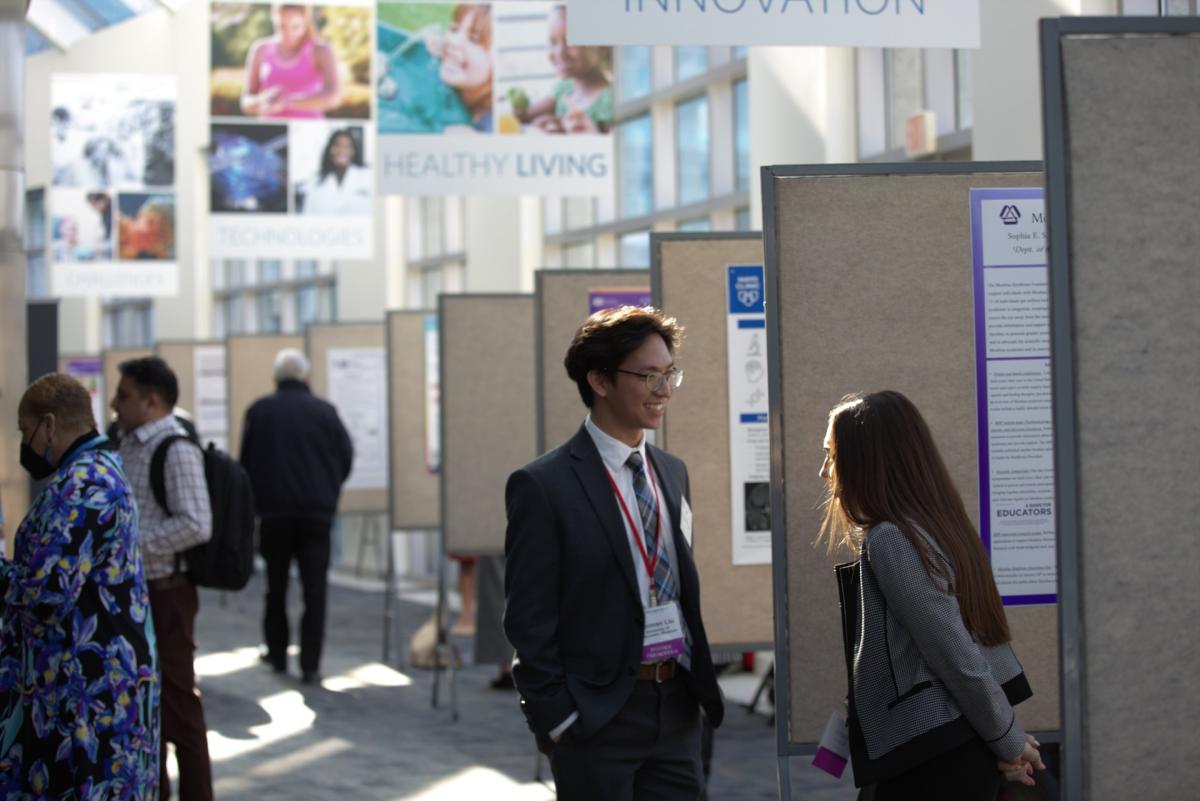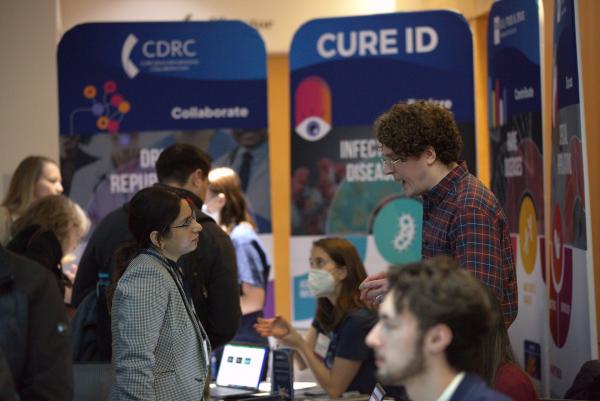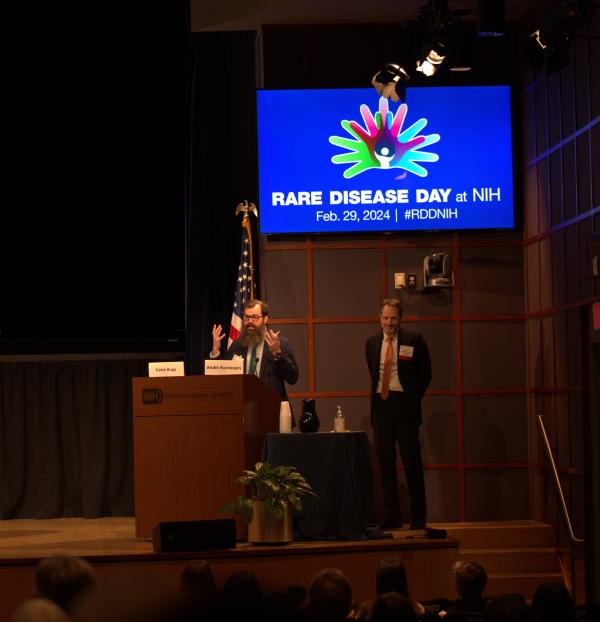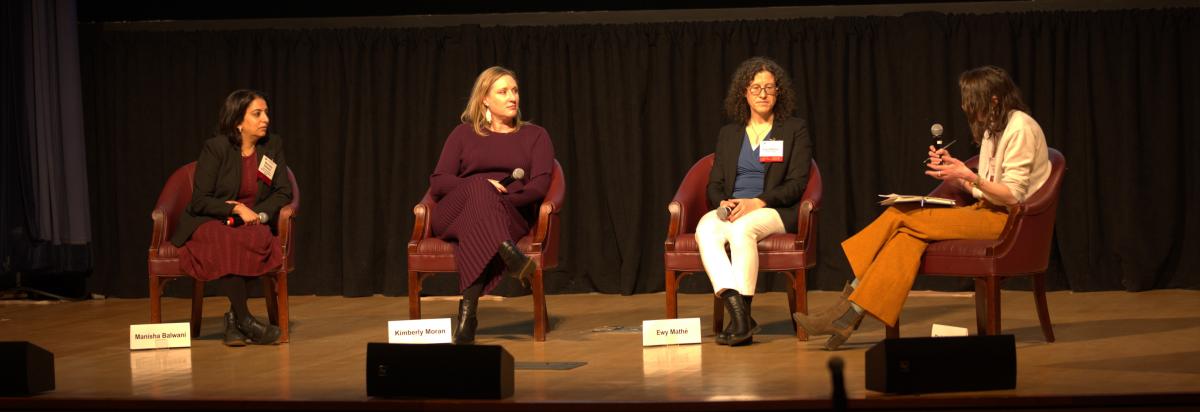A Rare Day Brings Fierce Focus to Rare Diseases
Rare Disease Day Highlights Tenacity of Love, Science
BY JENNIFER HARKER, THE NIH CATALYST

CREDIT: NCATS
Scientists presented their work on rare disease topics during a research poster showcase in the Natcher Conference Center during Rare Disease Day at NIH.
Leap year brings us an extra day every four years for the celestial and the earthly to sync. Rare days such as these also bring focus to rare diseases, which at NIH offers patients, family members, and the intramural and extramural scientific communities a day to showcase outcomes that reach far beyond synchronicity.
For example, few things are more moving than watching the progression of a child go from deep suffering to laughing and sledding in the Michigan snow. Not many families facing rare diseases have such heartwarming outcomes, but NIH’s commitment to battling the long diagnostic and treatment odyssey is making great strides toward ensuring more kids are laughing and playing in the snow by the time the next leap year rolls around.
Hundreds gathered on Feb. 29 at the Natcher Conference Center on the NIH Bethesda campus to speak of medical advances, network, and show their support for the rare disease community.

CREDIT: NCATS
Each year, the Rare Disease Day at NIH Exhibit Hall grows with booths and attendees.
Dominique Pichard, director of the NCATS Division of Rare Diseases Research Innovation, shared a story about her daughter’s lengthy journey to diagnosis of Rett syndrome. As a mother and physician, she vowed to improve this process for others. “I don’t want a single person affected by rare disease to have to have that long of a diagnostic and treatment odyssey,” she told the audience.
According to NCATS Director Joni Rutter, it takes an average of six years for accurate diagnosis of a rare disease. She shared the many ways in which NIH is advancing the research to speed such processes.
“We have uncovered common genetic threads that can lead to universal therapies, from gene editing and gene therapy approaches to antisense oligonucleotides,” Rutter said. “We can also be thinking about how we can design new clinical trials or basket trials that test one therapy on many different rare diseases. So, in this way, we are not just chasing treatments, we are leapfrogging toward cures.”

CREDIT: NCATS
Caleb Bupp (left) and André Bachmann (right) from Michigan State University (Grand Rapids, Michigan) shared their journey treating newborns and young children around the world during their presentation “Repurposing With Purpose: From Discovery to Rapid Treatment of Bachmann-Bupp Syndrome” (PMID: 37469105).
NIH CC CEO James Gilman also restated the CC’s commitment to rare diseases. “The clinical center does more rare disease research than any place else on the planet,” he said. “Still, of the 7,000 identified rare and neglected diseases for which we know the molecular cause, only about 500 have approved treatments. NIH is collaborating with multiple partners to speed up the development of effective treatments and the clinical center is proud to play an important role in those efforts.”
The Bespoke Gene Therapy Consortium, which is co-led by NCATS, involves a multi-IC collaboration and partnership with the Foundation for the NIH, the U.S. Food and Drug Administration (FDA), and multiple private organizations that work together to speed development of novel cell and gene therapies.
The FDA’s Office of Therapeutic Products, directed by Nicole Verdun, was created one year ago to address the significant increase in cell and gene therapy development. “The science is changing on a day-to-day basis,” Verdun said. “We hope to exponentially increase the number of gene therapies approved. We have been adding additional tools like concurrent submission and product review with other regulatory authorities, communication pilots, and increased use of the accelerated approval pathway. We are trying to lean in and figure out ways that we can partner with the rare disease community, because the goal is to get therapies to patients sooner.”

CREDIT: NCATS
Dressed in zebra print, attendees take in the art on display at Rare Disease Day at NIH.
Rare Disease Day at NIH is an annual daylong hybrid event jointly sponsored by NCATS and the CC. The event seeks to raise awareness about rare diseases by bringing together a broad audience that includes patients, patient advocates, caregivers, health care providers, researchers, trainees, students, industry representatives, and staff from government agencies.
This year’s event featured intramural and extramural scientific efforts, cross-agency partnerships, panel discussions with experts, rare diseases stories by patients living with a rare disease or their family members, in-person exhibits and scientific posters, and an art exhibition.

CREDIT: NCATS
Panel discussions were held throughout the day to facilitate open discussions about rare disease topics. This “Artificial Intelligence (AI) and Its Potential Role in Rare Diseases” panel was moderated by Christine Cutillo, health data scientist for AI ethics, NIH Office of Data Science Strategy (far right). Panelists from left to right: Manisha Balwani, professor and chief of the Division of Medical Genetics and Genomics, Icahn School of Medicine at Mount Sinai; Kimberly Moran, head of U.S. Rare Diseases at UBC, Inc.; and Ewy Mathé, director of the NCATS Informatics Core.
UNDERSTANDING THE GENETIC MECHANISMS BEHIND FRAGILE X SYNDROME
NIH-funded researchers studying Fragile X syndrome (FXS) uncovered new genetic mechanisms that go beyond mutations in FMR1, the gene associated with the disease. The scientists found changes in genome structure and silenced genes that expand our understanding of FXS and might be used in future studies to explore diagnosis and treatment for FXS and related disorders.
FXS is an inherited genetic condition that can lead to developmental delays, learning disabilities, and social and behavioral problems. It’s also associated with anxiety, hyperactivity, and autism spectrum disorder.
FMR1 is located on the X chromosome and contains a specific short repeat of the DNA sequence CGG. A mutation-length FMR1 can have over 200 repeats and that largely stops the production of its protein FMRP, which is needed for proper brain development. This is when FXS emerges.
But FMR1 may not be the sole explanation for FXS. The investigators sifted through multiple large datasets of tissues from people with and without FXS to study both the genome and factors that influence gene expression. They also collaborated with the NIH NeuroBioBank to study tissue from the caudate nucleus, a brain region linked to FXS.
The results unexpectedly showed more widespread structural and functional changes in the DNA, involving genes far beyond FMR1 that were silenced by deposits of heterochromatin—a genetic material that when folded too tightly can make genes less accessible. Some of the affected genes are essential for healthy neural connectivity and plasticity.
Termed beacons of repeat expansion anchored by contacting heterochromatin, or BREACHes, the researchers proposed that those silenced regions may help explain many of the intellectual and developmental difficulties experienced by people with FXS. (This research was funded by NIMH, NINDS, NICHD, and the NIH Common Fund's 4D Nucleome Program, PMID: 38134876)
[BY ARTHI RAMKUMAR, NIAID]
This page was last updated on Monday, December 2, 2024
